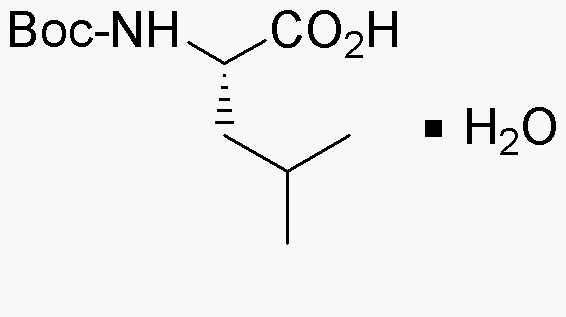Boc-L-leucine hydrate is widely utilized in research focused on:
- Peptide Synthesis: This compound serves as a protective group in the synthesis of peptides, allowing for the selective modification of amino acids without affecting others. This is crucial for creating complex peptide structures in pharmaceuticals.
- Drug Development: Its role in drug formulation is significant, particularly in designing prodrugs that enhance bioavailability. Researchers leverage its properties to improve the efficacy of therapeutic agents.
- Biotechnology: In the production of recombinant proteins, Boc-L-leucine hydrate is used to facilitate the incorporation of leucine into proteins, which can enhance their stability and functionality in various applications.
- Research in Molecular Biology: It is utilized in studies involving protein interactions and enzyme activity, providing insights into cellular mechanisms and aiding in the development of targeted therapies.
- Cosmetic Formulations: The compound finds application in the cosmetic industry, where it is used in formulations aimed at improving skin hydration and texture, leveraging its biochemical properties for skin health.
General Information
Properties
Safety and Regulations
Applications
Boc-L-leucine hydrate is widely utilized in research focused on:
- Peptide Synthesis: This compound serves as a protective group in the synthesis of peptides, allowing for the selective modification of amino acids without affecting others. This is crucial for creating complex peptide structures in pharmaceuticals.
- Drug Development: Its role in drug formulation is significant, particularly in designing prodrugs that enhance bioavailability. Researchers leverage its properties to improve the efficacy of therapeutic agents.
- Biotechnology: In the production of recombinant proteins, Boc-L-leucine hydrate is used to facilitate the incorporation of leucine into proteins, which can enhance their stability and functionality in various applications.
- Research in Molecular Biology: It is utilized in studies involving protein interactions and enzyme activity, providing insights into cellular mechanisms and aiding in the development of targeted therapies.
- Cosmetic Formulations: The compound finds application in the cosmetic industry, where it is used in formulations aimed at improving skin hydration and texture, leveraging its biochemical properties for skin health.
Documents
Safety Data Sheets (SDS)
The SDS provides comprehensive safety information on handling, storage, and disposal of the product.
Product Specification (PS)
The PS provides a comprehensive breakdown of the product’s properties, including chemical composition, physical state, purity, and storage requirements. It also details acceptable quality ranges and the product's intended applications.
Certificates of Analysis (COA)
Search for Certificates of Analysis (COA) by entering the products Lot Number. Lot and Batch Numbers can be found on a product’s label following the words ‘Lot’ or ‘Batch’.
*Catalog Number
*Lot Number
Certificates Of Origin (COO)
This COO confirms the country where the product was manufactured, and also details the materials and components used in it and whether it is derived from natural, synthetic, or other specific sources. This certificate may be required for customs, trade, and regulatory compliance.
*Catalog Number
*Lot Number
Safety Data Sheets (SDS)
The SDS provides comprehensive safety information on handling, storage, and disposal of the product.
DownloadProduct Specification (PS)
The PS provides a comprehensive breakdown of the product’s properties, including chemical composition, physical state, purity, and storage requirements. It also details acceptable quality ranges and the product's intended applications.
DownloadCertificates of Analysis (COA)
Search for Certificates of Analysis (COA) by entering the products Lot Number. Lot and Batch Numbers can be found on a product’s label following the words ‘Lot’ or ‘Batch’.
*Catalog Number
*Lot Number
Certificates Of Origin (COO)
This COO confirms the country where the product was manufactured, and also details the materials and components used in it and whether it is derived from natural, synthetic, or other specific sources. This certificate may be required for customs, trade, and regulatory compliance.


